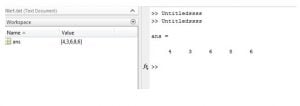

This structure has three fields - time, month, and raindata array. We will create a structure named mydata in the workspace to store data read from the file. Here we will use for loop for reading 3 sets of data and each time, it will read 7 rows and 5 columns. M = fscanf(fid, '%*s %*s\n%*s %*s %*s %*s\nM=%d\n\n', 1) īy default, fscanf reads data according to our format description until it does not find any match for the data, or it reaches the end of the file. To skip a data field, use an asterisk ('*') in the specifier.įor example, to read the headers and return the single value for M, we write − To skip literal characters in the file, include them in the format description. Open the file with fopen function and get the file identifier.ĭescribe the data in the file with format specifiers, such as ' %s' for a string, ' %d' for an integer, or ' %f' for a floating-point number. We will import data from this file and display this data. The header data stores the number of months M so we have M sets of measurements. The data in myfile.txt contains repeated sets of time, month and rainfall measurements at five places. The file stores rainfall data for three months June, July and August for the year 2012. We have a text data file 'myfile.txt' saved in our working directory. The fread function reads a stream of data at the byte or bit level.

The fgetl and fgets functions read one line of a file at a time, where a newline character separates each line. The fscanf function reads formatted data in a text or ASCII file. MATLAB provides the following functions for low-level import of text data files − Import Text Data Files with Low-Level I/O Move file position indicator to beginning of open file Open file, or obtain information about open files Read line from file, keeping newline characters Read line from file, removing newline characters MATLAB provides the following functions for read and write operations at the byte or character level − Function However, these functions need more detailed information about your file to work efficiently. The low-level file I/O functions in MATLAB allow the most control over reading or writing data to a file.

The importdata function is a high-level function.
#MATLAB WRITE TO NEW TXT FILR CODE#
In this example, let us import data from clipboard.Ĭopy the following lines to the clipboard −Ĭreate a script file and type the following code − When you run the file, it displays the following result − Our text file weeklydata.txt looks like this − Let us create a space-delimited ASCII file with column headers, named weeklydata.txt. In this example, we import a text file and specify Delimiter and Column Header. However, you must store it in the current directory. When you run the file, MATLAB displays the image file. Create a script file and type the following code in it −
#MATLAB WRITE TO NEW TXT FILR INSTALL#
Returns the detected delimiter character for the input ASCII file in delimiterOut and the detected number of header lines in headerlinesOut, using any of the input arguments in the previous syntaxes.īy default, Octave does not have support for importdata() function, so you will have to search and install this package to make following examples work with your Octave installation. Loads data from ASCII file, filename, or the clipboard, reading numeric data starting from line headerlinesIn+1. You can use delimiterIn with any of the input arguments in the above syntaxes.Ī = importdata(_, delimiterIn, headerlinesIn) Interprets delimiterIn as the column separator in ASCII file, filename, or the clipboard data. Loads data from the system clipboard rather than from a file. Loads data into array A from the file denoted by filename. The importdata function allows loading various data files of different formats. Importing data in MATLAB means loading data from an external file.


 0 kommentar(er)
0 kommentar(er)
